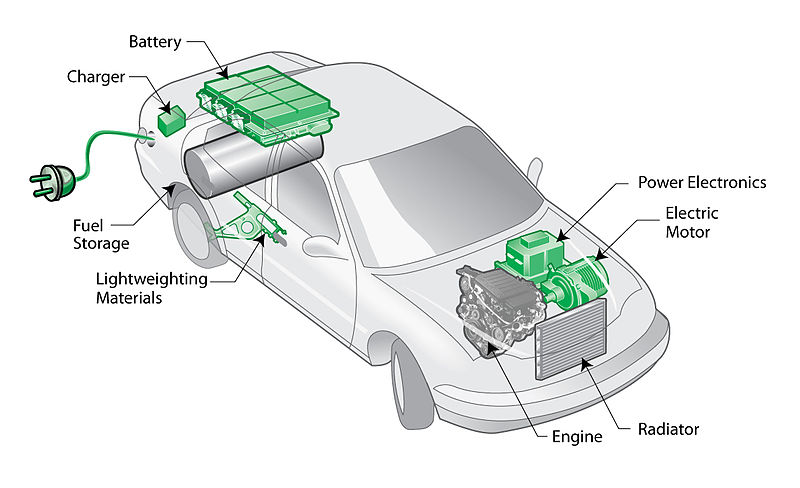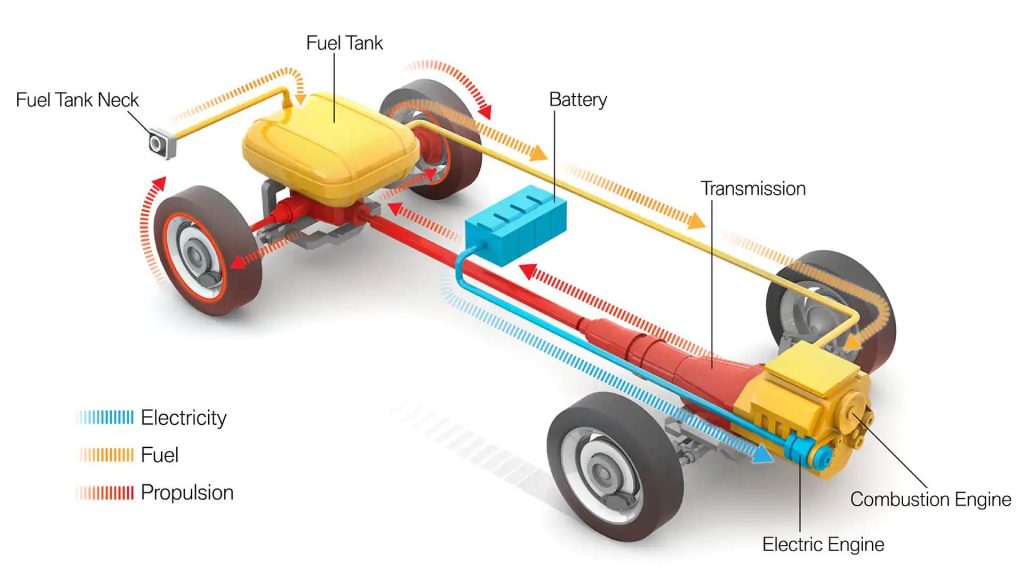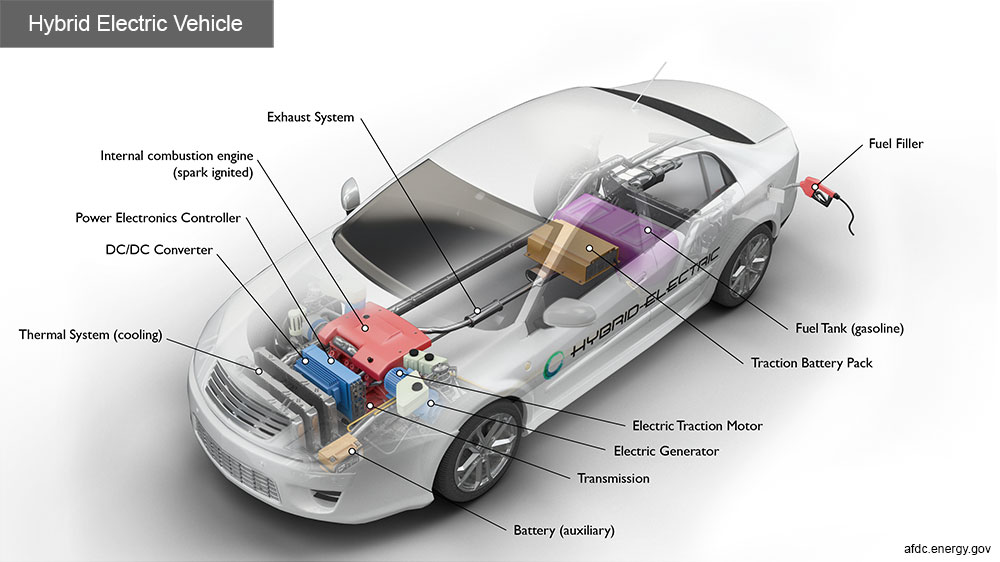
HEVs are vehicles propelled by more than one power source such as an engine and electric motor. They are classified by type and level. The advantages of HEVs are improved fuel economy, efficiency, and reduced emissions. The disadvantage of HEVs is cost. The cost aspect may be offset in years to come due to higher gas prices and improved HEV technologies. For more information on types and levels of HEVs, visit their respective pages in the menu on the left.

Hybrid electric vehicles are powered by an internal combustion engine and an electric motor, which uses energy stored in batteries. A hybrid electric vehicle cannot be plugged in to charge the battery. Instead, the battery is charged through regenerative braking and by the internal combustion engine. The extra power provided by the electric motor can potentially allow for a smaller engine. The battery can also power auxiliary loads like sound systems and headlights, and reduce engine idling when stopped. Together, these features result in better fuel economy without sacrificing performance.
COMPONENTS OF A HYBRID ELECTRIC CAR
Battery (auxiliary):
In an electric drive vehicle, the auxiliary battery provides electricity to start the car before the traction battery is engaged and also powers vehicle accessories.

DC/DC converter:
This device converts higher-voltage DC power from the traction battery pack to the lower-voltage DC power needed to run vehicle accessories and recharge the auxiliary battery.
Electric generator:
It generates electricity from the rotating wheels while braking, transferring that energy back to the traction battery pack. Some vehicles use motor generators that perform both the drive and regeneration functions.
Electric traction motor:
Using power from the traction battery pack, this motor drives the vehicle’s wheels. Some vehicles use motor generators that perform both the drive and regeneration functions.
Exhaust system:
The exhaust system channels the exhaust gases from the engine out through the tailpipe.
Fuel filler:
This is a filler or «nozzle» used to add fuel to the tank.

Fuel tank (gasoline):
This tank stores gasoline on board the vehicle until it’s needed by the engine.
Internal combustion engine (spark-ignited):
In this configuration, fuel is injected into either the intake manifold or the combustion chamber, where it is combined with air, and the air/fuel mix is ignited by the spark from a spark plug.
Power electronics controller:
This unit manages the flow of electrical energy delivered by the traction battery, controlling the speed of the electric traction motor and the torque it produces.
Thermal system (cooling):
This system maintains a proper operating temperature range of the engine, electric motor, power electronics, and other components.
Traction battery pack:
Stores electricity for use by the electric traction motor.
Transmission:
The transmission transfers mechanical power from the engine and/or electric traction motor to drive the wheels.
FUEL-EFFICIENT SYSTEM DESIGN
HEVs can be either mild or full hybrids, and full hybrids can be designed in series or parallel configurations.
• Mild hybrids—also called micro hybrids—use a battery and electric motor to help power the vehicle and can allow the engine to shut off when the vehicle stops (such as at traffic lights or in stop-and-go traffic), further improving fuel economy. Mild hybrid systems cannot power the vehicle using electricity alone. These vehicles generally cost less than full hybrids but provide less fuel economy benefits than full hybrids.
• Full hybrids have larger batteries and more powerful electric motors, which can power the vehicle for short distances and at low speeds. These vehicles cost more than mild hybrids but provide better fuel economy benefits.
ENERGY FLOW DIAGRAMS AND DESCRIPTIONS
1. Series (Extended-Range) Hybrid
A series hybrid is like a battery electric vehicle (BEV) in design. Here, the combustion engine drives an electric generator instead of directly driving the wheels. The generator both charges a battery and powers an electric motor that moves the vehicle. When large amounts of power are required, the motor draws electricity from both the battery and the generator. Series hybrids may also be referred to as extended-range electric vehicles (EREVs) or range-extended electric vehicles (REEVs) since the gas engine only generates electricity to be used by the electric motor and never directly drives the wheels. Modern examples include the Cadillac ELR, Chevrolet Volt, and Fisker Karma.
2. Parallel Hybrid
A parallel hybrid is propelled by both an internal combustion engine (ICE) and an electric motor connected to a mechanical transmission. Power distribution between the engine and the motor is varied so both run in their optimum operating region as much as possible. There is no separate generator in a parallel hybrid. Whenever the generator’s operation is needed, the motor functions as a generator. In a parallel mild hybrid, the vehicle can never drive in pure electric mode. The electric motor turns on only when a boost is needed.
3. Series-Parallel Hybrid
The vehicle can be powered by the gasoline engine working alone, the electric motor by itself, or by both energy converters working together. Power distribution between the engine and motor is designed so that the engine can run in its optimum operating range as much as possible.
Most hybrids use several advanced technologies:
Regenerative Braking. Regenerative braking recaptures energy normally lost during coasting or braking. It uses the forward motion of the wheels to turn the motor. This generates electricity and helps slow the vehicle.
Electric Motor Drive/Assist. The electric motor provides power to assist the engine in accelerating, passing, or hill climbing. This allows a smaller, more-efficient engine to be used. In some hybrids, the electric motor alone propels the vehicle at low speeds, where gasoline engines are least efficient.
Automatic Start/Stop. Automatically shuts off the engine when the vehicle comes to a stop and restarts it when the accelerator is pressed. This reduces wasted energy from idling.
ADVANTAGES & DISADVANTAGES OF HYBRID CARS
ADVANTAGES OF HYBRID CARS
Switching to a hybrid car has many advantages, a few of which we have highlighted below:
1. Environmentally Friendly
2. Economical
3. Less Fossil Fuel Dependent
4. Regenerative Braking System
5. Light Build
6. Higher Resale Value
DISADVANTAGES OF A HYBRID CAR
1. Less Power
2. Expensive to Purchase
3. Poorer Handling
4. High Maintenance Cost
5. High Voltage Batteries
Automotive World

Esta genial el aporte. Un cordial saludo.
Saludos